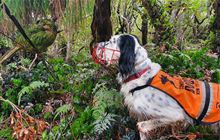DOC’s smallest wave of new recruits
Archived content: This media release was accurate on the date of publication.
Introduction
Potential candidates for one of DOC’s most intense programmes were put to the ‘conservation hero’ test recently, to see if they were ready to detect protected species and pests as Conservation Dogs.Date: 01 December 2021
The two-day training camp, held in Thames, saw five dedicated handlers and their furry companions completing a series of activities to see if they and their dogs were ready to be certified. A regular and rigorous process in the Conservation Dogs Programme which is supported by Kiwibank.
Department of Conservation (DOC) Senior Pest Detection Dog Advisor Finlay Buchanan says the training is required to see if the dogs and their handlers can meet a high standard to pass certification assessments.
“Conservation dog teams are involved in some of the most high-risk conservation activities from pest incursions on pest free islands, to detecting protected species for survey, to be monitored and/or moved to another place. We need to make sure the dogs can do this work effectively and safely.
“Dogs can pose a serious risk to protected species if they are not trained and handled correctly. Because of this the requirements for dogs and their handlers are very high.”
The two-day camp required the participating dog teams to complete a series of activities to help determine the dog’s ability to detect a certain species and the dog handler’s ability to manage their furry teammate.
To train a safe and successful dog, handlers must have experience of working with the target protected or pest species and dog-handling and training experience.
“Each dog is different, and the length of training can vary dependent on what they are training for. Our most recent candidates performed well and three of them (two German Shorthaired Pointers and a Border Collie) were deemed ready to sit their assessments to become pest detection dogs,” says Fin.
It takes around 18 months of daily training to become certified. Once certified they will still need to train several times a week for the duration of the dog’s working life (up to 10 years).
Of the most recent round of recruits, Fin says “it was good to see a mix of new and experienced handlers going through processes and making some real progress.
“These teams are really crucial parts of conservation and I’m excited to see a new wave of bright eyed and passionate conservationists – including the pups.”
Background Information
Conservation dogs
Well trained dog-handler teams have successfully been used for conservation for more than 40 years. New Zealand was the first country to use dogs to benefit conservation as far back as the 1890s.
Today, the Conservation Dogs Programme delivers services nationwide in partnership with Kiwibank.
Work undertaken includes:
- protecting the Hauraki Gulf and other pest-free islands from introduced pests
- helping monitor kiwi, blue duck/whio and kea on the West Coast.
The dog-handler teams are trained to sniff out either:
- protected species (mainly birds) for survey, to be monitored and/or moved to another place
- pest species (eg rodents, mustelids, Argentine ants, weeds) that would destroy our native wildlife in pest-free areas.
Contact
For media enquiries contact:
Email: media@doc.govt.nz

